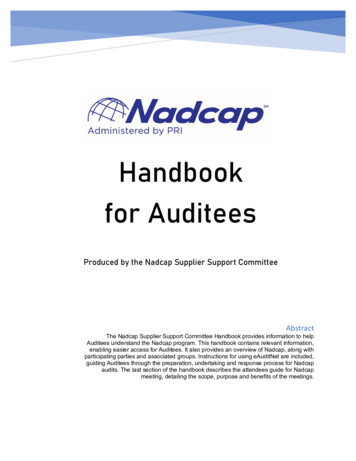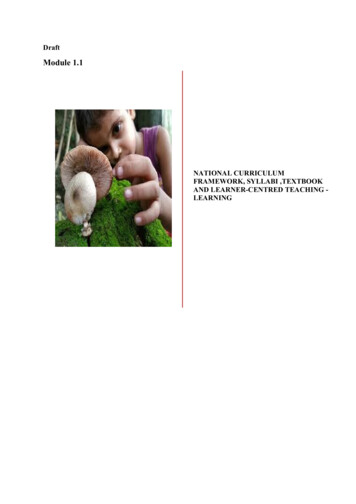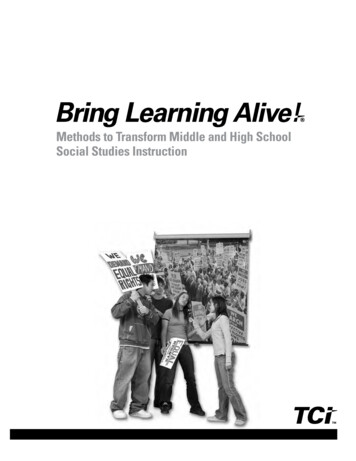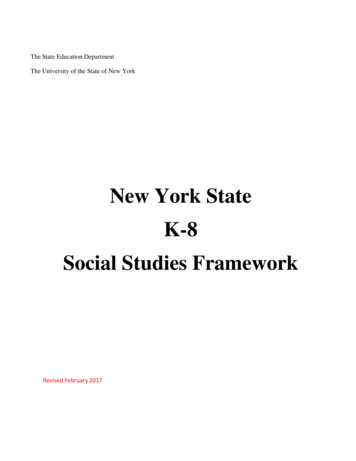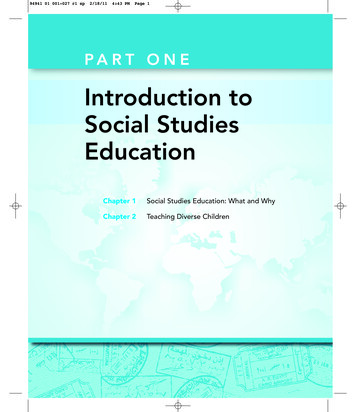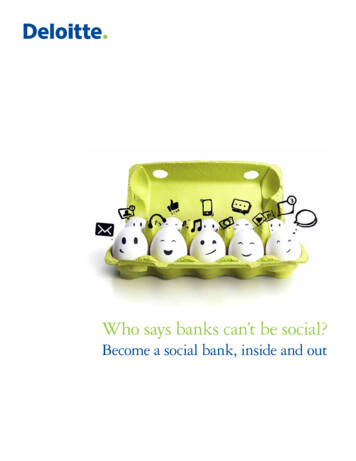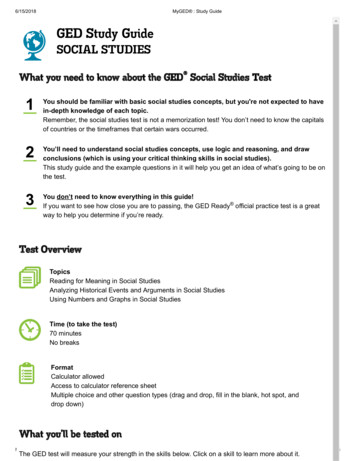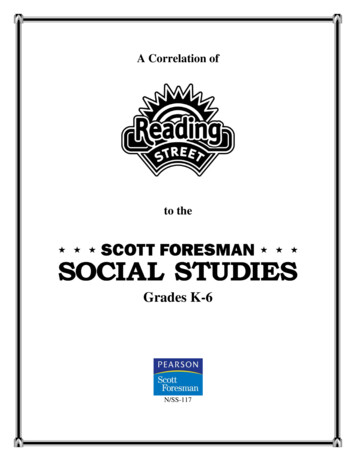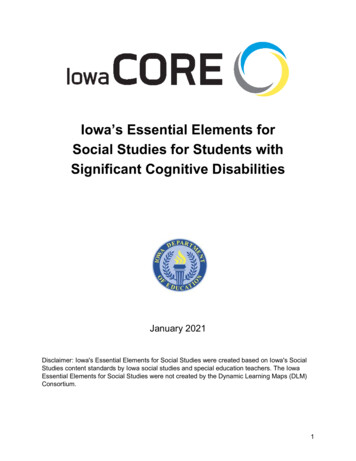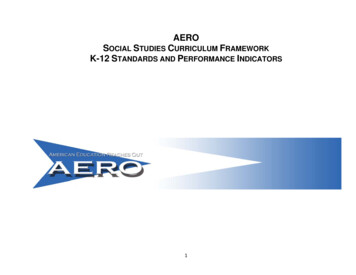
Transcription
AEROSOCIAL STUDIES CURRICULUM FRAMEWORKK-12 STANDARDS AND PERFORMANCE INDICATORS1
Table of ContentsIntroduction and Explanation of Framework ComponentsLongstanding Ideas, Renewed EmphasisInquiry and Social Studies PracticesC3 and AERO FrameworkTable 1: AERO Practices and C3 DimensionsAssessing the Social Studies Practices334566Table 2: AERO Social Studies Practices and Literacy Connections7AERO, International Baccalaureate Diploma Programme, and Advanced PlacementK-12 Framework ComponentsStandards, and Performance IndicatorsK-12 Components of the Framework.Grades K-2 Standards and Learning ProgressionsGrades 3-5 Standards and Learning ProgressionsGrades 6-8 Standards and Learning ProgressionsGrades 9-12 Standards and Learning ProgressionsHigh School Elective CoursesAppendix A: Literacy in History/Social Studies, Science, and Technical SubjectsReferences12131314152433415666802
Introduction and Explanation of Framework ComponentsProject AERO views social studies as a critical school subject that allows students to gain a comprehensive body of knowledge,understandings, and skills that will enable them to better understand the world as it was and currently is and provide them with the toolsnecessary to become critical and creative thinkers that can solve complex world problems now and in the future.The National Council for the Social Studies (NCSS) defines social studies as: the integrated study of the social sciences and humanities to promote civic competence. Within the school program, socialstudies provides coordinated, systematic study drawing upon such disciplines as anthropology, archaeology, economics,geography, history, law, philosophy, political science, psychology, religion, and sociology, as well as appropriate content fromthe humanities, mathematics, and natural sciences. The primary purpose of social studies is to help young people makeinformed and reasoned decisions for the public good as citizens of a culturally diverse, democratic society in an interdependentworld.The purpose of the AERO Social Studies Curriculum Framework is to provide schools with the foundational components for designing aKindergarten through Grade 12 aligned curriculum and assessment program that prepares students with the knowledge and intellectualprocesses, practices, and dispositions to be active, informed, engaged participants in public life.Longstanding Ideas, Renewed EmphasisThe authors of the original AERO Social Studies Framework (2002) designed standards which represented enduring ideas in the field andwere international in scope. The first version of the Framework included eight K-12 standards with learning progressions in grade bands: K2, 3-5, 6-8, and 9-12. The fundamental premise was that the standards remain consistent grade-to-grade, while evidence of learningprogresses over time. By design, specific content or course topics were not included, thus allowing schools maximum flexibility to buildcurricula consistent with their missions and/or specific program needs.During the revision process in 2012, the eight standards remained intact, but in response to requests from schools, the learning progressionswere identified for each grade level. This expansion resulted in tighter sequential alignment of skills and related content across the grades.Schools also requested the addition of suggested course and/or content topics to be added. This was done; for example, Grade 1 focused on3
family as context and grades six and seven on world regions. In addition, Enduring Understandings and Essential Questions were added foreach standard to provide focus for student inquiry to be central to the classroom teaching and learning experiences.The 2018-2019 revision process of the AERO Social Studies Framework has maintained the original K-12 standards and learningprogressions based on the strength of their substance and their continued viability as the foundation for a robust and rigorous Social Studiescurriculum. The Enduring Understandings and Essential Questions for each standard have also remained intact; however, the suggestedcourse study or topics were removed to once again provide schools with greater flexibility when designing curriculum. The process has alsorecognized the merits of the College, Career, and Civic Life (C3) Framework for Social Studies State Standards (NCSS, 2013), specifically,as it relates to the pedagogical shift to greater emphasis on inquiry in the classroom. Though the focus on inquiry is not new to AERO socialstudies, this iteration of the framework gives it explicit emphasis. Questioning is key to learning, and by its nature, social studies promotes theuse of questions throughout the learning process. As noted in the Scholarly Rationale for the C3 Framework, “A growing body of research onhow students learn school subjects such as social studies repeatedly teaches us that students need opportunities to ask questions, pursueanswers to those questions under the tutelage of expert teachers who can show them how to discipline their thinking processes, and take partin opportunities to communicate and act on their understandings.” (NCSS, 20).Inquiry and Social Studies PracticesIn the AERO Social Studies Curriculum Framework, questions play a key role in curriculum design. These questions aid students in theexploration of the disciplines in relation to the standards, while others transcend individual disciplinary categories and allow students todevelop the habits of mind required of a social scientist. Social scientists share similar practices which refer to those habits of mind that crossthe disciplines of social studies. The term practices is used instead of skills to stress that engaging in social studies inquiry requirescoordination of knowledge and skills (NRC, 2012).During the 2018-19 review process, five AERO Social Studies practices were developed, requiring students to:1. Develop Questions and Plan Inquiries2. Evaluate the Credibility of the Sources and Relevance of the Information to the Inquiry3. Construct Coherent, Reasoned Arguments and Explanations4. Communicate Conclusions From an Inquiry5. Take Informed Action for the Common Good4
C3 and AERO FrameworkThe C3 Framework resulted from the collaboration between representatives from several state educational agencies in the United States andvarious professional organizations. The process was coordinated by the National Council for the Social Studies (NCSS). The objectives ofthe effort were to:a. Enhance the rigor of the Social Studies disciplinesb. Build critical thinking, problem solving, and participatory skills to become engaged citizensc. Align academic programs to the Common Core State Standards for English/Language Arts and Literacy in Historyand Social StudiesThe C3 Framework contains four dimensions:Dimension 1: Developing Questions and Planning InquiriesDimension 2: Applying Disciplinary Tools and ConceptsDimension 3: Evaluating Sources and Using EvidenceDimension 4: Communicating Conclusions and Taking Informed ActionIt should be noted that the responsibility for education in the United States falls to the 50 individual states; there is no national curriculum perse. The developers recognized that fact and thus C3 “intentionally preserves the critical choices around the curricular content taught at eachgrade level as a decision best made by each state. It aims to support states creating standards that prepare young people for effective andsuccessful participation in college, careers, and civic life.” (C3, p. 6.) Dimension 2 includes descriptions of foundational concepts anddisciplinary knowledge and tools associated with civics, economics, geography and history. The concepts illustrate the disciplinary ideas, suchas political structures, economic decision making, spatial patterns, chronological sequencing, that help organize the curriculum and contentstates select. (C3, p.6) Dimension 2 does not, however, include content standards, leaving that responsibility to the states. In lieu of individualstate standards, the AERO Social Studies Framework with its deliberately developed and vetted standards and learning progressions providesthe necessary content standards that C3 does not.Dimensions 1,3, and 4 are linked to the AERO Social Studies practices outlined above. These practices reflect the Inquiry Literacies noted inthe C3 Framework (2013). They describe the habits of mind that are critical for students to engage with disciplinary content, concepts, andskills. They are designed to enable students to acquire the necessary competencies to become informed global citizens who take constructiveaction for the common good.Table 1 shows the alignment of the AERO Social Studies Practices and the C3 Dimensions:5
AERO Social Studies Practices1.Develop Questions and Plan InquiriesC3 DimensionsDimension 1: Developing Questions and Planning InquiriesNote: AERO Social Studies Standards replace Dimension 22.Evaluate the Credibility of the Sources and RelevanceDimension 3: Evaluating Sources and Using Evidenceof the Information to the Inquiry3.Construct Coherent, Reasoned Arguments andExplanations4. Communicate Conclusions from an InquiryDimension 4: Communicating Conclusions and Taking InformedAction5. Take Informed Action for the Common GoodAssessing the Social Studies PracticesIn order to integrate the planning and assessment of the practices within the social studies units, the AERO Framework has linked them toexisting reading, writing, speaking and listening standards. This linkage emphasizes those skills that explicitly connect to inquiry, andrecognizes the responsibility that social studies plays in honing those skills, such as determining explicit information, drawing logicalinferences, citing evidence, etc. The practices can be assessed in Grades K-5 using the AERO English/Language Arts Standards in reading,writing, speaking and listening. For Grades 6-12, the practices can be assessed by way of the English/Language Arts Literacy in History/Social Studies, Science and Technical Subjects for Reading and Writing (see Appendix A), and in the AERO English/Language ArtsStandards for Speaking, Listening, and Writing. The following table illustrates the connections between the AERO Social Studies Practicesand those standards for Grades 6-12. The literacy standards for History/Social Studies (H/SS) are highlighted in yellow; the English/LanguageArts Standards for Listening and Speaking are highlighted in green; the Writing Standards are highlighted in gray.6
Table 2: AERO Social Studies Practices and Literacy ConnectionsAERO SOCIAL STUDIESPRACTICESDevelop questions and planinquiries.Explanation Develop and refinequestions used to initiateand sustain an inquiryIdentify sources helpful infocusing the inquiry andanswering the questions.Identify the focus of aninquiry as a local,regional, or global issue,challenge, or concern.History/ Social Studies Literacy StandardConnectionsH/SS Reading 1.1Read closely to determine what the text says explicitly and to makelogical inferences from it; cite specific textual evidence whenwriting or speaking to support conclusions drawn from the text.H/SS Writing 1.7Conduct short as well as more sustained research projects based onfocused questions, demonstrating understanding of the subjectunder investigation.ELA Listening and Speaking LS.1Prepare for and participate effectively in a range of conversationsand collaborations with diverse partners, building on others' ideasand expressing their own clearly and persuasively.Evaluate the credibility of thesources and the relevance ofthe information to the inquiry. Construct coherent, reasonedarguments and explanations Gather information thatreflects multipleperspectives from avariety of sources.Analyze and interpret datato assess the credibilityH/SS Reading 1.1Read closely to determine what the text says explicitly and to makelogical inferences from it; cite specific textual evidence whenwriting or speaking to support conclusions drawn from the text.H/SS Reading 1.27
and relevance of thesources in order to refinethe inquiryUse relevant evidencefrom credible sources inorder to formulate claimsand counterclaims andfurther develop logicallysequenced, reasonedarguments andexplanations.Determine central ideas or themes of a text and analyze theirdevelopment; summarize the key supporting details and ideas.H/SS Reading 1.3Analyze how and why individuals, events, or ideas develop andinteract over the course of a text.H/SS Reading 1.4Interpret words and phrases as they are used in a text, includingdetermining technical, connotative, and figurative meanings, andanalyze how specific word choices shape meaning or tone.H/SS Reading 1.5Analyze the structure of texts, including how specific sentences,paragraphs, and larger portions of the text (e.g., a section, chapter,scene, or stanza) relate to each other and the whole.H/SS Reading 1.6Assess how point of view or purpose shapes the content and styleof a text.H/SS Reading 1.7Integrate and evaluate content presented in diverse media andformats, including visually and quantitatively, as well as in words.H/SS Reading 8.1Delineate and evaluate the argument and specific claims in a text,including the validity of the reasoning as well as the relevance andsufficiency of the evidence.H/SS Reading 1.98
Analyze how two or more texts address similar themes or topics inorder to build knowledge or to compare the approaches the authorstake.H/SS Reading 1.10Read and comprehend complex literary and informational textsindependently and proficiently.H/SS Writing 1.2Write informative/explanatory texts to examine and conveycomplex ideas and information clearly and accurately through theeffective selection, organization.H/SS Writing 1.7Conduct short as well as more sustained research projects based onfocused questions, demonstrating understanding of the subjectunder investigation.ELA Writing Standard W.1Write arguments to support claims in an analysis of substantivetopics or texts using valid reasoning and relevant and sufficientevidence.H/SS Writing 1.8Gather relevant information from multiple print and digital sources,assess the credibility and accuracy of each source, and integrate theinformation while avoiding plagiarism.H/SS Writing 1.9Draw evidence from literary or informational texts to supportanalysis, reflection, and research.9
H/SS Writing 1.10Write routinely over extended time frames (time for research,reflection, and revision) and shorter time frames (a single sitting ora day or two) for a range of tasks, purposes, and audiences.ELA Listening and Speaking LS.1Prepare for and participate effectively in a range of conversationsand collaborations with diverse partners, building on others' ideasand expressing their own clearly and persuasively.Communicate conclusionsfrom an inquiry. Take informed action for thecommon good. Share the results of theinquiry with others.Choose appropriatemethods and media basedon purpose and audience.Use the conclusions froman inquiry to determineappropriate. responses toissues, challenges, andconcerns in society.Take informed actionbased on results of aninquiry.H/SS Reading 1.1Read closely to determine what the text says explicitly and to makelogical inferences from it; cite specific textual evidence whenwriting or speaking to support conclusions drawn from the text.ELA Writing W.2Write informative/explanatory texts to examine and conveycomplex ideas and information clearly and accurately through theeffective selection, organization, and analysis of content.H/SS Writing 1.3Write narratives to develop real or imagined experiences or eventsusing effective technique, well-chosen details and well-structuredevent sequences.H/SS Writing 1.4Produce clear and coherent writing in which the development,organization, and style are appropriate to task, purpose, andaudience.H/SS Writing 1.5Develop and strengthen writing as needed by planning, revising,editing, rewriting, or trying a new approach.10
H/SS Writing 1.6Use technology, including the Internet, to produce and publishwriting and to interact and collaborate with others.H/SS Writing 1.7Conduct short as well as more sustained research projects based onfocused questions, demonstrating understanding of the subjectunder investigation.ELA Writing W.1Write arguments to support claims in an analysis of substantivetopics or texts using valid reasoning and relevant and sufficientevidence.H/SS Writing 1.8Gather relevant information from multiple print and digital sources,assess the credibility and accuracy of each source, and integrate theinformation while avoiding plagiarism.ELA Listening and Speaking LS.1Prepare for and participate effectively in a range of conversationsand collaborations with diverse partners, building on others' ideasand expressing their own clearly and persuasively.ELA Listening and Speaking LS.2Integrate and evaluate information presented in diverse media andformats, including visually, quantitatively, and orally.ELA Listening and Speaking LS.3Evaluate a speaker's point of view, reasoning, and use of evidenceand rhetoric.11
ELA Listening and Speaking LS.4Present information, findings, and supporting evidence such thatlisteners can follow the line of reasoning and the organization,development, and style are appropriate to task, purpose, andaudience.ELA Listening and Speaking LS.5Make strategic use of digital media and visual displays of data toexpress information and enhance understanding of presentations.ELA Listening and Speaking LS.6Adapt speech to a variety of contexts and communicative tasks,demonstrating command of formal English when indicated orappropriate.AERO, International Baccalaureate Diploma Programme, and Advanced PlacementMany schools that have adopted Project AERO also offer the IB Diploma Programme and/or Advanced Placement courses in Grades 11 and12. Project AERO does not work at cross purposes with either one of these programs. As the framework makes clear, many of the AEROperformance indicators in the prioritized social studies disciplines are met by the end of the tenth grade. Of those that remain, many could becomfortably taught within the specialized AP courses or the framework of Group III (Individuals and Society) IBDP courses.12
K-12 Framework ComponentsAt the K-12 level the framework includes content standards, grade level performance indicators, enduring understandings and essentialquestions. All are key curricular “macro” components that should be included as schools design a fully- aligned student learning program forsocial studies. In addition, schools should consider developing and adopting a K-12 philosophy, inquiry-based transfer tasks, common rubrics,and any instructional agreements specific to the context of the school. This will establish the full complement of guiding documents for acomprehensive K-12 program.Standards and Performance IndicatorsThe AERO Social Studies Standards are statements describing what students should know and be able to demonstrate by the end of Grade 12.Because the schools AERO seeks to serve are independent, their practices vary widely. Any set of performance indicators that would bemeaningful to these schools have to be sufficiently flexible to appeal to a diverse group of schools with widely different histories, geographiclocations, cultural traditions, and student bodies. As a result, Project AERO believes that the social studies performance indicators are largelyfree of historically specific information. The performance indicators serve as criteria for assessing and monitoring student learning. Duringthe teaching and learning process, teachers design learning experiences that are aligned to these expectations.The graphic below illustrates the K-12 components of the framework.13
14
AERO K-12 Social Studies FrameworkGrade LevelKK-2 Enduring UnderstandingsAnd Essential Questionsfor Standard 1Standard 112(Time, Continuity, and Change) Students will understand patterns of change and continuity, relationships between people and eventsthrough time, and various interpretations of these relationships.K-2 Enduring Understandings:K-2 Essential Questions: The past is a broad term referring to events that happened orpeople who lived before now.The past cannot be changed. What is meant by “the past?” Knowing about the past helps us to understand the presentbetter. How is the past different from the present?Why is knowing about the past important? The past is preserved in many ways, including in stories and intales of folk heroes. How is knowledge about the past preserved? Events follow a sequence or happen in a given order. 15
1.2.b. Differentiate between people, places,and events in the past, present and future.Performance IndicatorsGrades K-21.2.a Identify stories about past events,people, places or situations1.2.b. Differentiate between people, places, andevents in the past, present and future.1.2.c. Relate stories about past events, people,places, or situations to help our understanding ofthe past and present.Grade LevelK-2 Enduring UnderstandingsAnd Essential Questionsfor Standard 2Standard 21.2.a. Identify stories about past events, people,places or situations.K12(Connections and Conflict) Students will understand causes and effects of interaction among societies, including trade, systems ofinternational exchange, war, and diplomacy.K-2 Enduring Understandings:K-2 Essential Questions: What is conflict? Conflict may occur when people disagree. People in communities cooperate (work together) to meet theirneeds and solve conflicts. What is cooperation? Conflict occurs for many reasons, but essentially becausepeople have different wants and needs. Why do groups of people have conflict? People can work together in many ways How can people work together?16
Performance IndicatorsGrades K-22.2.a. Give examples of conflict andcooperation among individuals and groups.2.2.a. Give examples of conflict andcooperation among individuals and groups2.2.a. Give examples of conflict and cooperationamong individuals and groups.2.2.b. Identify and describe factors thatcontribute to cooperation and factors that maycause conflict.2.2.c. Identify that some ways of dealing withdisagreements work better than others.2.2.b. Identify and describe factors thatcontribute to cooperation and factors that maycause conflict.2.2.c. Identify that some ways of dealing withdisagreements work better than others.Grade LevelK-2 Enduring UnderstandingsAnd Essential Questionsfor Standard 3Standard 3K12(Geography) Students will understand the interactions and relationship between human societies and their physical environment.K-2 Essential Questions: Why does someone’s physical environment matter?K-2 Enduring Understandings: People depend on their physical environment. Different physical environments influence different cultures indistinct ways.People adapt their physical environments in different ways. Maps and globes and geographical techniques help people tounderstand better their physical environment. Regions typically refer to areas of the globe with commonphysical characteristics and which are in near proximity17 How can you explain where a place is located? What makes one place different from another place?
Performance IndicatorsGrades K-23.2.b. Explain the concept of location.3.2.c. Use maps and graphs, tables, anddiagrams to read and display geographicinformation.K-2 Enduring UnderstandingsAnd Essential Questionsfor Standard 43.2.c. Use maps and graphs, tables, anddiagrams to read and display geographicinformation.3.2.b. Explain the concept of location.3.2.c. Use maps and graphs, tables, anddiagrams to read and display geographicinformation.3.2.d. Locate and distinguish betweenlandforms.Grade LevelStandard 43.2.a. Describe ways in which people dependon the physical environment.K3.2.e. Describe the influence of landforms andgeographic features on human population andcultures.3.2.f. Differentiate between ways in whichpeople from different cultures think about andadapt to the physical environment.12(Culture) Students will understand cultural and intellectual developments and interactions among societies.K-2 Enduring Understandings: Culture refers to the common language, norms, values, beliefs,and practices of a distinct people. Culture and a belief system (religion) are closely related. Culture satisfies basic human needs, such as a sense ofbelonging. Peoples’ actions influence their culture; someone’s cultureinfluences their actions.18K-2 Essential Questions: What is culture? Why does culture matter?What can we learn about societies through their culture?How is it possible to distinguish between two cultures? What does it mean to belong? How does someone know how to behave, even when thatperson is not told how to? How do different groups of people living in one place influencea culture?
4.2.b. Describe how people in different typesof institutions and organizations (e.g. families,schools, local religious communities, clubs,etc.) interact with each other.4.2.b. Describe how people in different typesof institutions and organizations (e.g. families,schools, local religious communities, clubs,etc.) interact with each other.4.2.a. Identify regional folk heroes, stories, orsongs that have contributed to the developmentof a region’s cultural history.Performance IndicatorsGrades K-24.2.b. Describe how people in different types ofinstitutions and organizations (e.g. families,schools, local religious communities, clubs, etc.)interact with each other.4.2.c. Describe how people from differentcultures interact with the environment, such asthe use of resources, shelter and transportation.4.2.d. Compare and contrast socialenvironments in different cultures.4.2.e. Describe the expectations of how to act inone’s own culture and compare this withbehavioral expectations of other culturesGrade LevelStandard 5K12(Society and Identity) Students will understand social systems and structures and how these influence individuals.K-2 Enduring Understandings K-2 Essential Questions: How do people and groups support their community?How are we connected to others? People live in groups and depend on each other to help meettheir needs.Communities offer connection, relationship, and belonging toindividuals.All citizens have important roles in the community. Culture helps individuals express who they areEvery individual has a unique identity. What can we learn about ourselves by studying cultures inother places?How do social, cultural, and national norms influence identity? 19
Performance IndicatorsGrades K-2K-2 Enduring UnderstandingsAnd Essential Questionsfor Standard 5 Social systems and structures set expectations for appropriateand inappropriate behavior.People organize themselves and interact with one another indifferent ways in different environments.Individuals choose whether to follow societal norms andexpectations. Why are some behaviors acceptable in certain environmentsand not in others?Is behavior always a choice?5.2.a. Identify connections between who theyare as a person and their place in the world.5.2.a. Identify connections between who theyare as a person and their place in the world.5.2.c. Recognize that individual people arepart of a group.5.2.b. Distinguish themselves as individualsfrom others.5.2.e. Explain why people live in social groups(e.g. families, communities, and nation).5.2.c. Recognize that individual people arepart of a group.5.2.e. Explain why people live in social groups(e.g. families, communities, and nation).5.2.f. Identify roles and behaviors that peopledemonstrate when in group situations.205.2.d. Recognize culturally and contextuallyappropriate and inappropriate social behaviorand the impact of making choices aboutbehavior.5.2.g. Identify opportunities for choice inpersonal identity.
Grade LevelPerformance IndicatorsGrades K-2K-2 Enduring UnderstandingsAnd Essential Questionsfor Standard 6Standard 6K12(Government) Students will understand why societies create and adopt systems of governance and how they address human needs,rights, responsibilities and citizenship.K-2 Enduring Understandings:K-2 Essential Questions: Every person has certain rights within and responsibilities to What does it mean to be a responsible citizen (of a community,broader society.nation, the world)? Governments are major sources of power within a society. What is power? How is power gained, justified, and used?How do competing interests influence how power is distributed? Members of a community establish structures to maintain anorderly community. Why and how are governments created, structured, maintained,and changed? Governments help provide stability within a country byestablishing laws and by resolving conflicts. How does government affect people’s lives?6.2.a. Identify and explain rights andresponsibilities of the individual in relation tohis or her social group, including thecharacteristics of good citizens.6.2.a. Identify and explain rights andresponsibilities of the individual in relation tohis or her social group, including thecharacteristics of good citizens.6.2.b. Identify sources and purposes ofauthority in various settings (e.g., mayor,chief, ruler, principal, and teacher).6.2.b. Identify sources and purposes ofauthority in various settings (e.g., mayor,chief, ruler, principal, and teacher).6.2.d. Describe the impact of families andschools on their lives.6.2.c. Identify qualities that leaders need inorder to meet their responsibilities.6.2.e. Explain reasons for the importance ofleadership and service.6.2.f. Identify various principles used fordecision-making and problem solving(fairness, cooperation, individualresponsibility, etc.).216.2.a. Explain rights and responsibilities of theindividual in relation to his or her social group,including the characteristics of good citizens.6.2.d. Describe the impact of families andschools on their lives.6.
In addition, Enduring Understandings and Essential Questions were added for each standard to provide focus for student inquiry to be central to the classroom teaching and learning experiences. The 2018-2019 revision process of the AERO Social Studies Framework has maintained
